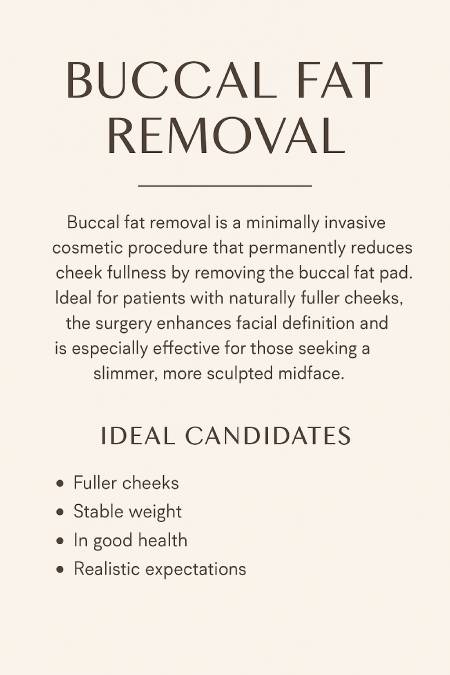Buccal fat removal is a popular procedure for facial contouring. It is designed to reduce fullness in the lower cheeks by surgically removing the buccal fat. Buccal fat is naturally present in everyone, but can be more prominent in some individuals. Prominent buccal fat creates a rounder appearance. Many people are unhappy with this as they do not have defined cheekbones. Facial contouring procedures have become increasingly popular due to the shift towards a more sculpted facial aesthetic. Buccal fat removal is a minimally invasive procedure that can help patients achieve this look. Those who are interested in the procedure often wonder, “Is buccal fat removal permanent?” We share the answer to this question, along with additional information about facial plastic surgery, below.
Is Buccal Fat Removal Permanent?
Buccal fat removal is considered a permanent procedure. The procedure involves removing part of or the entire buccal fat pad from the cheek by creating an incision inside the cheek. The fat pad is carefully removed, and the incision is closed. Once the buccal fat is removed, it does not regenerate. The buccal fat pad is unlike weight-related fat deposits. It is an encapsulated pad found in the cheek and does not expand or shrink with weight changes. For many people, buccal fat removal creates a defined and sculpted look once the pad is removed. To ensure the procedure is right for you, a skilled facial plastic surgeon will determine if you are a good candidate during a consultation.

Who Is a Good Candidate for Buccal Fat Removal?
Buccal fat removal is an excellent procedure that offers amazing results. However, the procedure is not for everyone. Below, you will find who can benefit from the procedure.
Full Cheeks
Ideal candidates for buccal fat removal are individuals with full or rounded cheeks. Fuller cheeks often result in a “baby-faced” appearance. Facial plastic surgery can remove the prominent buccal fat pad to create a more sculpted and contoured appearance. For those with narrow or hollowed cheeks, the procedure can have a negative impact on one’s overall facial aesthetic. It can result in a gaunt and aged appearance. This procedure is best for patients with fuller cheeks.
Stable Weight
Patients should be in good overall health and have maintained a stable weight for a prolonged period of time. Fat distribution from weight gain or loss can impact facial volume. Fluctuations in facial volume can impact the long-term results of the procedure, so it is essential to maintain a consistent weight before surgery. To ensure optimal results, avoid fluctuations in weight.
Certain Age Groups
There is no specific age limit for buccal fat removal. However, it is often best for patients in their 20s to 40s due to the adequate skin elasticity of this age group. The quality of your skin is essential, as it will significantly impact the naturalness of your results. Older patients may look sunken or older without buccal fat. This is not the case with younger patients, as their skin tends to recover more quickly after surgery.
Good Overall Health
As with any surgery, patients must be in good overall health to ensure the success of the procedure and the recovery process. Additionally, patients with chronic conditions need to have them under control to lower the risk of complications and promote proper healing. It is best if patients are nonsmokers. If you do smoke, share that information with your surgeon at the consultation. You will need to quit smoking before and after surgery. Smoking increases the risk of surgical complications and negatively impacts the recovery process.
Realistic Expectations
Buccal fat removal offers amazing results. It can reshape and sculpt your midface. It provides an enhancement to your natural looks. Understanding the benefits and limitations of the procedure is necessary. Having realistic expectations is important, so be sure to share your aesthetic goals with your surgeon during the consultation. They can answer your questions and further develop your understanding of the procedure.
Buccal Fat Removal Procedure
Once it has been determined that you are a suitable candidate, you can proceed with the procedure. The surgery is usually performed under general anesthesia to ensure your comfort during the procedure. The procedure is smooth and takes approximately two hours to complete. If you are undergoing multiple procedures simultaneously, the surgical time is often longer.
Once you are under general anesthesia, an incision is made on the inside of the mouth, typically near the second upper molar, hidden in the inner cheek lining. The buccal fat is carefully removed. Once removed, the incisions are closed. In many cases, the stitches are absorbable, so you do not need to get them removed later. However, it is essential not to disrupt the stitches as you heal. The procedure may differ if you are undergoing additional procedures. For example, patients who get buccal fat removal and a facelift have different incision locations. Your surgeon will provide you with all of this information during your consultation, so you are prepared before surgery.
Recovering From Buccal Fat Removal
Buccal fat removal is performed on an outpatient basis. After the procedure is complete and you are medically cleared, you can go home the same day. You will be provided with aftercare instructions. It is essential to follow these instructions exactly to ensure accurate results. You will also be prescribed medication to ensure a smooth recovery process. Take the medication as prescribed and contact your surgeon immediately if you experience any side effects or issues.
You may notice swelling, bruising, and slight discomfort in the first week or two. These effects are completely normal and should subside within a few weeks. Resting and taking your prescribed medication can help. You may be required to consume a liquid diet for the first week. This is necessary if you have stitches inside your mouth from the incision. It is crucial to keep the incision clean. You must properly rinse and clean the incision per your surgeon’s instructions.
Most people get back to work after two weeks. However, it is important to listen to your body and rest when necessary. By the one-month mark, you should be able to notice your results. You will notice a sleeker face with a more contoured look. Be sure to attend all of your follow-up appointments, so your surgeon can monitor your progress.
Facial Plastic Surgery
If you are interested in buccal fat removal, contact Dr. Brent Moelleken and his team today to schedule a consultation!

